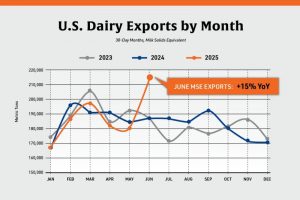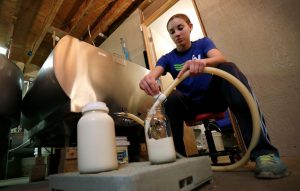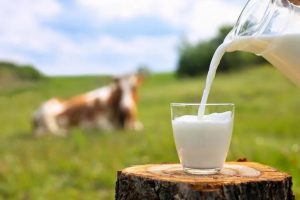
At some point in history, this was the case, until the industry began to package it and intermediation became the law.
But apart from these issues, there is a whole movement of people who defend the consumption of raw or unpasteurized milk, convinced that its properties are incomparable to those of pasteurized milk.
In Argentina, the sale to the public of raw milk of any species is expressly prohibited by current legislation (article 556 bis of the CAA).
Raw milk may contain dangerous bacteria, such as Salmonella, E. coli, Listeria, Campylobacter, and others that cause foodborne illnesses, and this is undeniable.
The FDA warns that bacteria in raw milk can be especially dangerous for vulnerable groups such as children, the elderly, pregnant women or those with weakened immune systems such as people with HIV, cancer or transplants.
But the truth is that, just as we take the responsibility to wash vegetables or cook meat well to avoid the same issues, we could also… boil the milk and bye-bye!
In any case, we would be pasteurizing it and the issue here is to drink it raw. What are the advantages argued by those who defend this practice?
Raw milk protects children from asthma, allergies, infections, and gut issues
Yet it’s illegal in 37 states… pic.twitter.com/A49g9AjS9C
— Paul Saladino, MD (@paulsaladinomd) September 6, 2023
The consumption of raw milk would have benefits, including better taste, better nutrition and building a healthier immune system, facilitated by the introduction of beneficial microorganisms that are lost in pasteurization.
Compounds that contribute to better assimilation of calcium would also be lost, resulting in better bone composition and health. Another health advantage is the gaining of natural antioxidants, precursors of vitamin A.
The enzymes and bacteria that raw milk maintains, also provide gustatory and olfactory nuances, which enhance the flavor and texture.
On the other hand, advocates of raw milk also highlight as a benefit of the direct sale of milk, the possibility for the producer to eliminate the middleman and sell directly to the consumer, which would give greater profitability. However, today there is low-scale pasteurizing equipment that could well be implemented on farms.
The question is, which weighs more in the balance, the risks or the benefits. In any case, the law rules, and the marketing of raw milk varies around the world.
Some countries have complete bans, such as Argentina and Brazil, and others have partial bans.
In Africa, indigenous communities where milk consumption is common, milk is not pasteurized.
In rural areas of Asia generally, as well as in large cities, it is not pasteurized either. In most Asian countries, there are no laws prohibiting raw milk, and if there are, they are rarely enforced.
But in Japan, unpasteurized milk is very rare. Singapore, for example, bans it.
The European Union requires raw milk and its derivatives to be identified on their packaging. Member States are free to add certain other requirements.
France has a long cheese-making tradition, and raw milk cheeses, which account for almost 18% of production, are of a higher quality than cheeses made from pasteurized milk.
In Germany, packaged raw milk is called Vorzugsmilch, and must provide information on producer, shelf life and special warnings. Their distribution license has strict quality standards, and only 80 German farmers have one.
Raw, bulk milk can only be sold at the farm where it was produced, the day it was drawn or the next, and warn that it must be boiled before consumption.
Unpasteurized milk may not be sold in stores in Norway, Sweden, Finland and Denmark. Only limited sales are allowed on licensed farms, subject to strict controls.
The sale of raw milk for consumption is banned in Scotland after a series of deaths in 1983, and while it is legal in England, Wales and Northern Ireland, the only registered producers are in England.
In Brazil, the sale of raw milk was banned in 1939. It is not legal to consume raw milk in that country.
The sale of raw milk for human consumption is also prohibited in Canada, but cheeses aged more than 60 days are not.
Forty-three U.S. states allow the sale of raw milk, although the FDA reported that, in 2002, consumption of raw milk caused illness in more than 200 people.
Prior to pasteurization, many dairies fed poor quality feed to their cattle, and these produced milk that was riddled with dangerous bacteria. Pasteurization was the only way to make it safe. And because pasteurization has been a standard for many years, it is now widely assumed that raw milk is dangerous. Is it?
Cornell University’s Department of Food Science compiled data indicating that pathogenic microorganisms are present in only 0.87% to 12.6% of raw milk samples.
Food freedom advocates cite libertarian arguments in claiming the basic civil right of each person to weigh the risks and benefits in choosing their food…and there are no flaws in their logic. Or are there?
Raw milk and its derivatives are illegal throughout Australia, and an exception has been made for Roquefort cheeses and animal owners, who can consume their raw milk.
Raw milk and its raw derivatives can be manufactured and sold in New Zealand, but are highly regulated.
And what do you think about raw milk? About freedom of choice as a civil right of the consumer? And about the independence and profitability of dairy farmers?
Now I read them! And don’t forget that consuming dairy products is ALWAYS good for you.
Valeria Hamann























